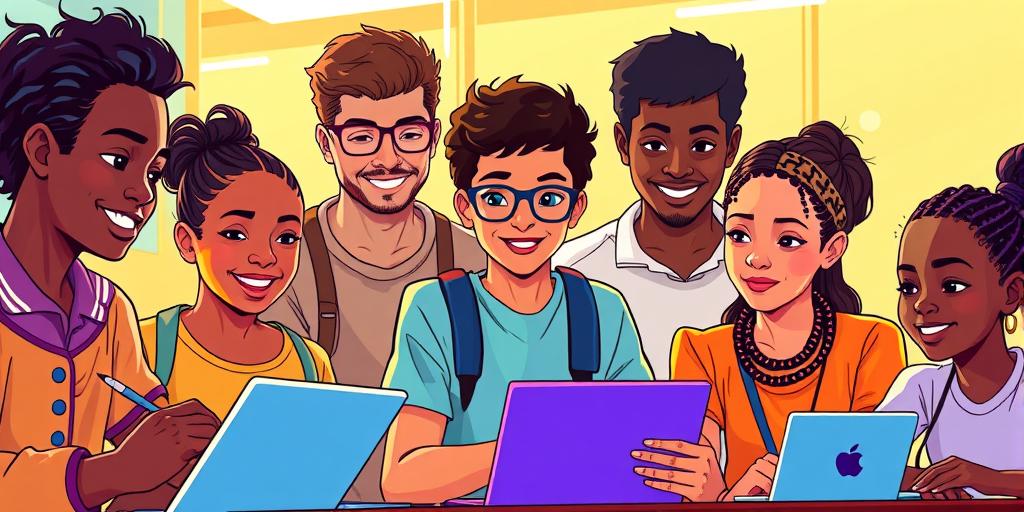Have you ever wondered how technology could bridge the gap in education and make learning opportunities available to everyone, regardless of location or background? Prepare to be amazed! Artificial intelligence (AI) is rapidly transforming the educational landscape, creating a more accessible and personalized learning experience for students worldwide. AI-powered tools are no longer a futuristic fantasy; they’re revolutionizing how we teach and learn, ensuring that education truly becomes a right, not a privilege. This article will explore the incredible ways AI is democratizing education and empowering learners globally.
AI-Powered Personalized Learning: A Revolution in Education
Imagine a world where each student receives a customized learning path, tailored precisely to their individual needs, strengths, and weaknesses. This isn’t science fiction; it’s the reality AI is creating. AI-powered platforms analyze student performance, identifying areas needing improvement and adjusting the curriculum accordingly. This dynamic approach ensures students aren’t stuck with a one-size-fits-all approach that can often leave some behind. Adaptive learning platforms utilize AI algorithms to personalize lessons, provide targeted feedback, and offer customized practice exercises. These tools ensure students are challenged appropriately, preventing boredom from overly easy material or discouragement from overly difficult tasks. This targeted, personalized approach significantly improves learning outcomes and boosts student confidence, leading to increased engagement and a love for learning.
Adaptive Learning Platforms: Tailoring Education to Individual Needs
The power of AI in education extends beyond simple adjustments. Adaptive learning platforms are designed to be incredibly dynamic and responsive. These platforms don’t just adjust difficulty; they also adapt the learning style, the content, and even the pace of instruction to match the student’s preferences and learning patterns. This means a student who learns best through visual aids will receive more visual content, while a student who prefers hands-on activities will be presented with more interactive exercises. This personalized approach maximizes learning efficiency and makes education far more engaging and effective for all students.
AI-Driven Assessment and Feedback: Enhancing Student Performance
AI is also revolutionizing how we assess student progress. Automated essay scoring, for example, uses natural language processing (NLP) to analyze student writing, providing detailed feedback on grammar, style, and content. This AI-powered assessment not only saves educators time but also provides students with more frequent and targeted feedback than is possible with traditional methods. This constant feedback loop helps students identify their weaknesses, improve their writing skills, and gain a deeper understanding of the material, leading to more significant improvements in their overall performance. This also makes the feedback more objective and helps avoid potential human biases in grading.
Accessibility for All: Breaking Down Barriers to Education
AI’s role in democratizing education is particularly impactful for students who face unique challenges or barriers. AI-powered tools provide a lifeline for students with learning disabilities, enabling them to access educational resources that are specifically designed to meet their needs. Text-to-speech software, for instance, helps students with dyslexia or reading difficulties access the material, while translation tools help students who don’t speak the primary language of instruction. AI-powered tools are proving especially beneficial for students in remote locations, providing access to quality education that may have been previously unavailable. These tools reduce the impact of geographic location, socioeconomic status, and other factors that can create significant inequalities in access to education. This is particularly relevant for bridging the educational divide in underserved communities.
AI-Powered Tools for Students with Disabilities
For students with learning disabilities, AI can be transformative. AI-powered tools can help students with dyslexia by providing text-to-speech and speech-to-text capabilities, personalized feedback on their writing, and specialized vocabulary-building tools. For students with ADHD, AI can provide a more structured and focused learning environment through personalized schedules and reminders. This approach helps make the learning process more inclusive and ensures that students with disabilities are given the support they need to succeed.
Overcoming Geographical Limitations: Education Without Boundaries
Students in remote or rural areas, often lacking access to quality education, can now benefit immensely from AI-powered online learning platforms. These platforms provide educational materials, virtual tutoring, and interactive learning tools, removing the traditional barriers of location and resource limitations. AI-powered language translation tools further enhance this accessibility, breaking down language barriers and providing learning materials in students’ native languages. This innovative approach is changing the landscape of global education, making it truly accessible to all.
The Future of AI in Education: Endless Possibilities
As AI technology continues to evolve, its applications in education will only expand. We can anticipate even more personalized learning experiences, sophisticated assessment tools, and innovative solutions that address unique learning challenges. The integration of AI in education is not just about technology; it is about creating a more equitable, accessible, and effective learning environment for every student, regardless of their background, location, or abilities. The future of education is bright, and AI is paving the way for a more inclusive and successful learning experience for all.
AI and the Teacher’s Role: Collaboration, Not Replacement
It is crucial to understand that AI in education is not about replacing teachers; it’s about empowering them. AI-powered tools can automate tedious tasks, providing teachers with more time to focus on individual student needs and personalized instruction. This collaboration between AI and educators results in a far more enriching and supportive learning experience for every student. The teacher remains the central figure, guiding students, fostering critical thinking, and building meaningful relationships.
Embrace the future of education; it’s more accessible, personalized, and innovative than ever before! Start exploring AI-powered educational tools today and unlock the incredible potential of technology to transform how we teach and learn. The potential for growth is immense!




